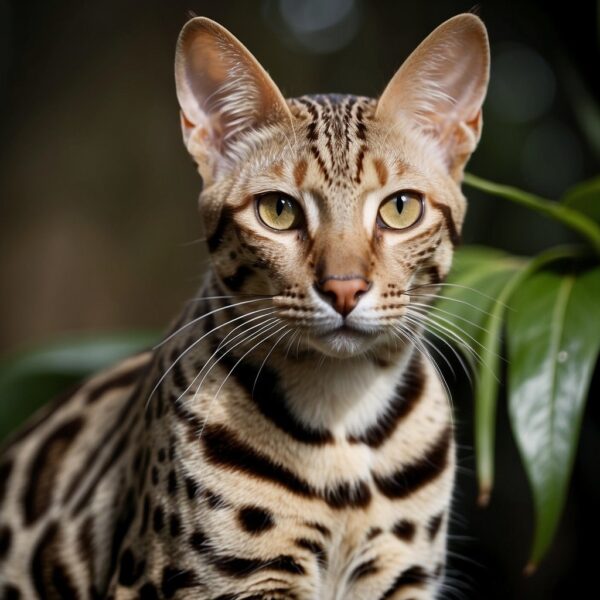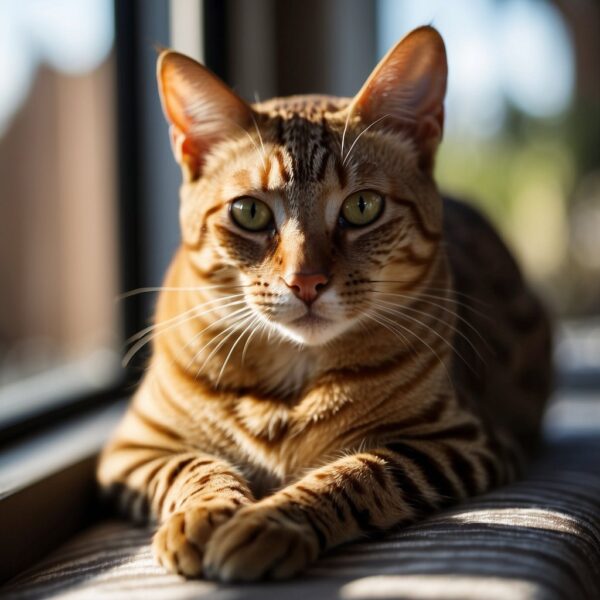
Ocicat Breed: Characteristics and Care Guide
The Ocicat is a breed that stands out for its remarkable wild look, boasting spots reminiscent of an ocelot—hence its name. Despite its ferocious feline appearance, this breed possesses a friendly and sociable nature. It was first bred in the United States and, interestingly, has no recent wild DNA in its gene pool, making it entirely domestic.
This breed’s enthusiasm and vocal personality make it a charming companion. The Ocicat has a lithe and muscular physique, covered with a short and sleek coat that further accentuates its exotic appeal. Its intriguing history traces back to an accidental breeding in the 1960s, resulting from a cross between an Abyssinian and a Siamese cat, later incorporating the American Shorthair to meet specific breed standards.
Key Takeaways
- The Ocicat mimics the appearance of a wild ocelot but is entirely domestic.
- Originating from an accidental crossbreeding, it has a history rooted in the United States.
- Characterized by a spotted coat, the Ocicat has a muscular build and a sociable temperament.
Origin and History
The Ocicat is a distinctive breed that combines the physical traits of its Abyssinian and Siamese ancestors, while its name reflects its resemblance to the wild ocelot. This wholly domestic cat emerged from experimental breeding in the mid-20th century.
Ancestral Roots
The Abyssinian and Siamese are the cornerstone breeds behind the Ocicat’s ancestry. The breed boasts no recent wild DNA but was named for its similarity to the ocelot. This appearance is attributed to the carefully selected traits from its ancestors, which include:
- The Abyssinian, known for its agouti or ticked coat
- The Siamese, contributing its pointed color scheme and blue almond-shaped eyes
Development of the Breed
The genesis of the Ocicat dates back to 1964 in Michigan. Breeder Virginia Daly embarked on a project to produce an Abyssinian-pointed Siamese. The crossbreeding unexpectedly yielded an ivory kitten with golden spots named Tonga. Though not initially aiming for a new breed, this serendipitous result set the stage for the Ocicat’s evolution.
American Shorthairs were introduced into the breeding program to add size and substance, thus refining the breed further. By 1987, the International Cat Association recognized the Ocicat as a breed. Noteworthy is that the cat named Tonga, the first known Ocicat, inadvertently became the progenitor of the breed due to its distinctive spotted coat.
Physical Characteristics
This breed artfully combines a wild appearance with domestic charm, characterized by its distinct coat and robust build.
Appearance
They possess a striking resemblance to the wild ocelot, despite being entirely domestic. Ocicats boast almond-shaped eyes and their ears sit at a 45-degree angle, enhancing their wild look.
Coat and Colors
The Ocicat’s coat is short and satiny with a unique spotted pattern. Notable for the variety of colors, they can have coats ranging from chocolate to lavender, with each hair displaying bands of color.
Body Structure
A full-grown Ocicat typically weighs up to 15 pounds, displaying a solid and muscular body. They have wedge-shaped heads, large oval paws, and a tail that tapers slightly. This build contributes to their athletic agility.

Frequently Asked Questions
The Ocicat is a breed full of distinct traits and interesting origins. This FAQ section provides succinct answers to common curiosities regarding the Ocicat breed.
What are the defining characteristics of the Ocicat’s personality?
The Ocicat exhibits a social and playful disposition, often characterized by a high level of activity and intelligence. They are known for being outgoing and interactive, showing traits similar to dogs, such as enjoying fetch.
How can one distinguish an Ocicat from other tabby breeds?
Distinct from other tabby breeds, Ocicats have large, muscular bodies with a wild appearance reminiscent of the ocelot. Their coats are spotted, and the breed displays a variety of colors, including chocolate, cinnamon, and others.
What is the average lifespan of an Ocicat?
Ocicats typically enjoy a long lifespan, often ranging between 10 and 15 years. This can extend further with proper care and regular veterinary check-ups.
How does the size of an Ocicat compare with other cat breeds?
The Ocicat is a medium-to-large breed, with adults weighing between 6 and 15 pounds. Males are generally more massive and heavier than females, which is a distinguishing feature when compared to smaller domestic cats.
What are the genetic origins of the Ocicat breed?
Their genetic lineage traces back to a mix of Abyssinian, Siamese, and American Shorthair breeds, intentionally bred to produce a domestic cat with a spotted coat resembling a wild ocelot.
Is the Ocicat breed considered a rare breed, and if so, why?
The Ocicat breed is relatively rare due to its more recent development and the specific breeding required to maintain its unique characteristics. It originated from experimental breeding in the 1960s, and thus, it has a shorter history compared to more established breeds.